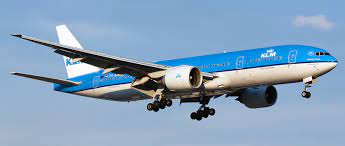When one of the aircraft’s engines failed, the flight was about halfway between Bangkok and Amsterdam and was diverted.
A KLM-operated Boeing 777-200ER had an engine failure on May 26 as it was about halfway through a journey from Bangkok to Amsterdam. The airplane was forced to reroute to Dubai as a result, where it has been for almost a day.
incident information
KLM flight KL876 left Bangkok at 12:10 local time on Friday, May 26th, according to information from FlightRadar24.com. 12 staff members and 286 passengers were on board. When an engine malfunction occurred, the Boeing 777-200ER was in Iranian airspace and had to come to a stop.
The plane was located about 540 nautical miles (nm) (1,000 km) northeast of Dubai, according to The Aviation Herald. The crew chose to detour to the UAE city rather than an Iranian facility as a result.

The PH-BQL-registered aircraft fell from FL340 to FL200 while traveling to Dubai International Airport. About 105 minutes after starting the detour, it landed there without further incident.
The Airbus 777-200ER is still in Dubai.
The approximately 17-and-a-half-year-old 777-200ER is still in Dubai as of the time of publication. Given the size of the airport and the fact that Emirates has its maintenance section there, “Emirates Engineering,” the plane should have all the tools it needs to be repaired and returned to service. Of course, how long the jet stays in the UAE will depend on how serious the problem is and whether certain parts are available.
It is possible that passengers would have finally been moved on alternative aircraft to Amsterdam due to the amount of time spent on the ground. KLM operates a single daily flight to Dubai using a variety of Boeing 777-200ER, 777-300ER, and 787-10 aircraft. The 787-9 is occasionally used on this route as well.
Why the crew didn’t go to a nearby airport instead
Crews have chosen not to fly to the closest acceptable airfield, as we’ve already seen with a number of Air France-KLM 777 engine problems. A KLM 777-300ER bound for So Paulo experienced an engine failure on May 9th, forcing a detour to Amsterdam. An Air France 777-300ER bound for Los Angeles made a turn back to Paris on January 4 after experiencing engine trouble over London. In these cases, the airlines took the deliberate choice to fly a bit longer and return their aircraft to “home base” as opposed to an international airport. Therefore, despite the 777 implicated in the incident on May 26 being hours away from Amsterdam, the crew opted to land in Dubai rather than Mashhad (MHD), Iran’s second biggest airport, which was closer. The airport has two asphalt runways, the longest of which is 12,877 feet (3,925 meters) long. Why did this choice get made?
We simply need to look at Norwegian’s 737 diversion event at the end of 2018 to understand why an emergency landing in Iran should be avoided, if at all feasible, to provide an answer to this question. The 737 MAX was forced to detour to Shiraz in Iran from its original destination of Oslo.
There, the airplane was abandoned for two months. The US and other Western nations’ sanctions against Iran were (and are) the cause of the prolonged grounding. Therefore, it is completely forbidden to export any critical technology, including airplane engines.
Iranian restrictions on the import of aircraft engines would have also increased complexity. When discussions on lifting sanctions were taking place, the US experienced a government shutdown, which made matters worse. Given that the US government is currently getting closer to its debt ceiling once more, this situation could have happened again.
In conclusion, airlines would prefer to avoid the political, administrative, and diplomatic complications that can arise from a detour to Iran.




